Time Traveler
A master decoy carver and creator of painstakingly accurate scale models and dioramas, Tom Boozer is keeping history alive from his workshop in South Carolina's Lowcountry
A master decoy carver and creator of painstakingly accurate scale models and dioramas, Tom Boozer is keeping history alive from his workshop in South Carolina's Lowcountry

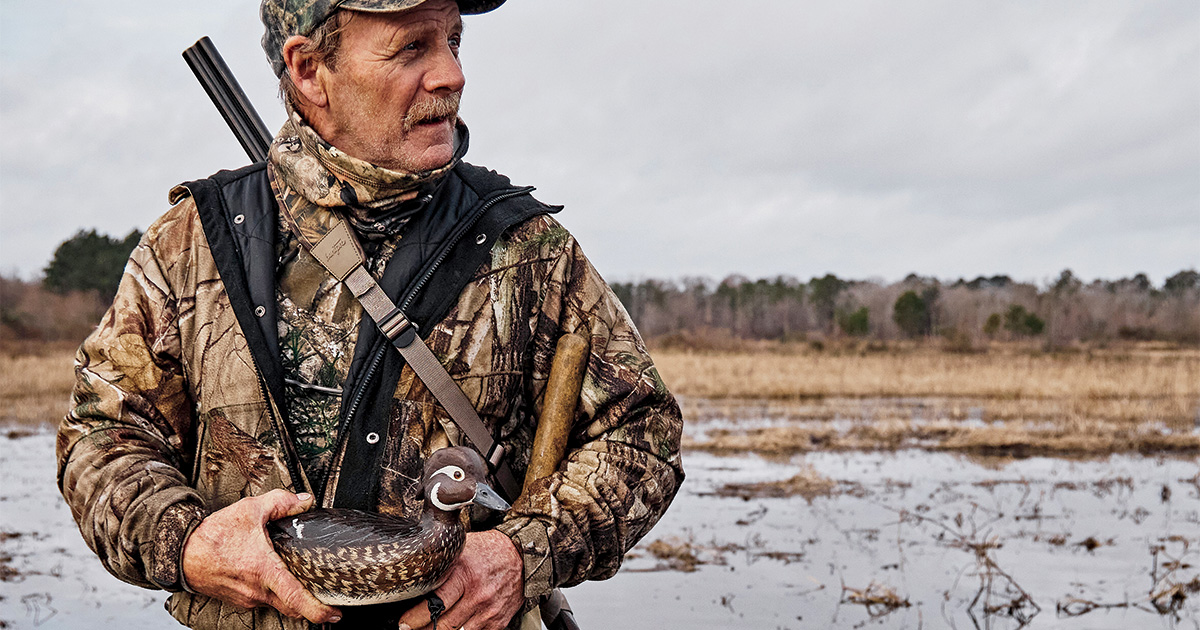
“I know I’m crazy,” Tom Boozer says. “Don’t you think I’d have to be crazy to do this?”
At that moment, I was standing in Boozer’s workshop, hunched over with my hands on my knees, a bit wonder-struck at a wooden boat model residing in a small glass case. Boozer’s workshop is a two-story barn-garage-gallery mashup nestled under the soaring live oaks and draperies of Spanish moss that mark the South Carolina Lowcountry. Here, you smell salt marsh and shavings from fresh-cut juniper, and there are expansive views of a winding tidal creek and the Intracoastal Waterway just south of Charleston. But I wasn’t there for the views. The object of my fascination was a 12 1/2-inch-long wooden sneak skiff armed with a three-barreled, 4-gauge battery gun. It was an intricately detailed, historically accurate scale model of one of the small, deadly skiffs used by market hunters in the 19th and early 20th centuries to gun incredible numbers of ducks and geese.
The tiny shotgun barrels—musket barrels converted to a flintlock system—were less than three inches long. Inside the skiff were tiny hand-carved paddles, perfect models of the ones used by the gunners to close the distance on rafts of resting birds. A tiny wooden crate held a tiny canvas bag of shot, a miniscule brass powder flask, and a metal can of percussion caps. There was a carefully rendered ramrod, with a metal tip, the size of a toothpick. And draped over the stern of the boat were a half-dozen hand-carved and hand-painted canvasback drakes. Each one would fit inside a butter bean.
Tom Boozer may be crazy, but his kind of crazy enables the rest of us to enter worlds where imagination and painstaking attention to detail come together to foster new ways of appreciating history. If you’ve ever wondered what it was like to be a market hunter, to shoot ducks until your shoulders couldn’t bear to shoot any more, or to sneak into gunning range under cover of night and touch off a punt gun the size of a war cannon, then you understand why I was a bit awestruck. You can read about the old market hunting days and visit the handful of museums around the country that help tell the old stories. But one of the best ways, and certainly among the most interesting, is counterintuitive: Spend a little time with a little carving, marveling at the miniature world Boozer summons with his catalog of gunning boat models and duck club dioramas.
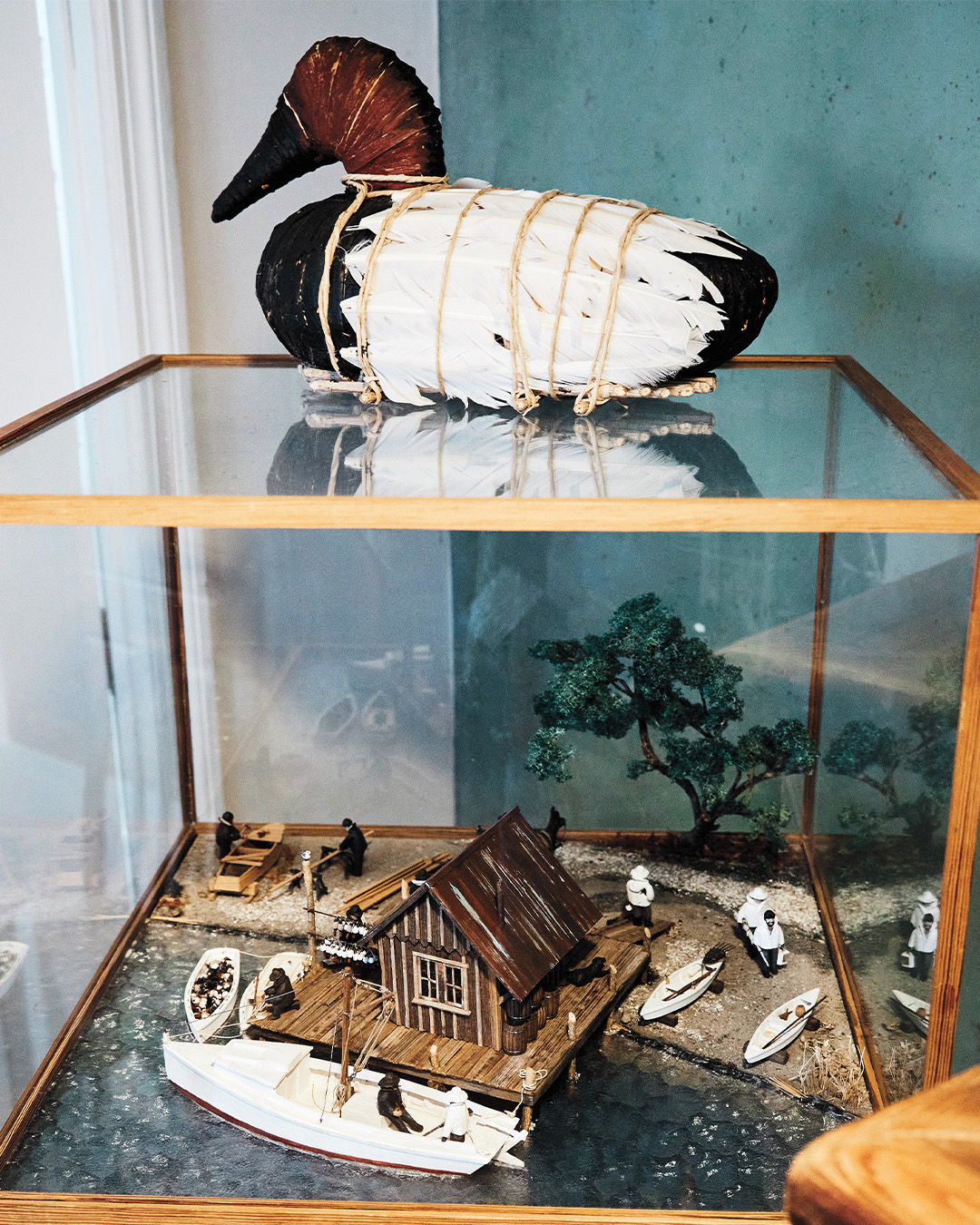
Many of Boozer’s carvings document life during the market hunting era. Historically accurate and incredibly detailed, these scale-model reproductions invite viewers to learn about and appreciate this unique period of waterfowling history.
The Palmetto State artist has a wide reputation as a fine carver of hollow-body wooden duck decoys. He carves shorebirds and working turkey decoys—yes, they’re a thing, and an increasingly popular thing, at that. But among a growing number of waterfowlers intrigued with the lore-rich market hunting period, Boozer is known for his historically accurate, exquisitely detailed scale models of the small skiffs employed by the market hunters of Chesapeake Bay and the Outer Banks of North Carolina. The boats he models are documented in the landmark book The Outlaw Gunner, by Harry M. Walsh, a native son of the Chesapeake Bay region and surgeon who practiced in Easton, Maryland, for many years. Published in 1971, the book remains one of the foundational works of literature that have framed a modern understanding of the market hunting era. And it’s a blast to read.
Over a lifetime of collecting, Walsh put together an extensive assemblage of the boats, guns, and gear used by Chesapeake Bay market hunters, and he stored them at his large historic farm outside Trappe, Maryland. And over the last four decades, Boozer has built scale models of three of the best-known gunning boats documented in the book—a flat-bottom skiff with a battery gun, a night gunner, and a punt gun skiff—plus models of a Barnegat Bay sneakbox, detailed dioramas of hunting clubs and historic sites, and a trove of oyster sloops. And he’s just begun work on his 31st scale model of Jenny, the South Carolina shrimp boat made famous in the movie Forrest Gump.
While his downstairs shop is where he does most of his decoy work—he uses a 200-year-old drawknife to shape his birds—an upstairs carving room is set aside for his exquisitely detailed models and miniatures. The room is filled with Audubon prints and dioramas of duck camps. Here he fashions items such as padlocks from tiny pieces of brass, gun barrels made with metal tubing, and the inches-long wood stocks of guns such as old Browning Auto-5s. He works the materials with drill bits that Boozer says are “hardly a hair’s width across” and dental tools he’s filed and shaped for specific carving cuts. He points to a shotgun in the bottom of the night gunner’s boat. To make its exposed hammer, he scrounged a piece of “pre-rusted” sheet metal from a junkyard and used a 1/16-inch microfile to work the curve of the hammer’s ear. The file makes the noise of a squirrel working over a nut. When he finished, you could cover the hammer with a .410 shotshell primer.
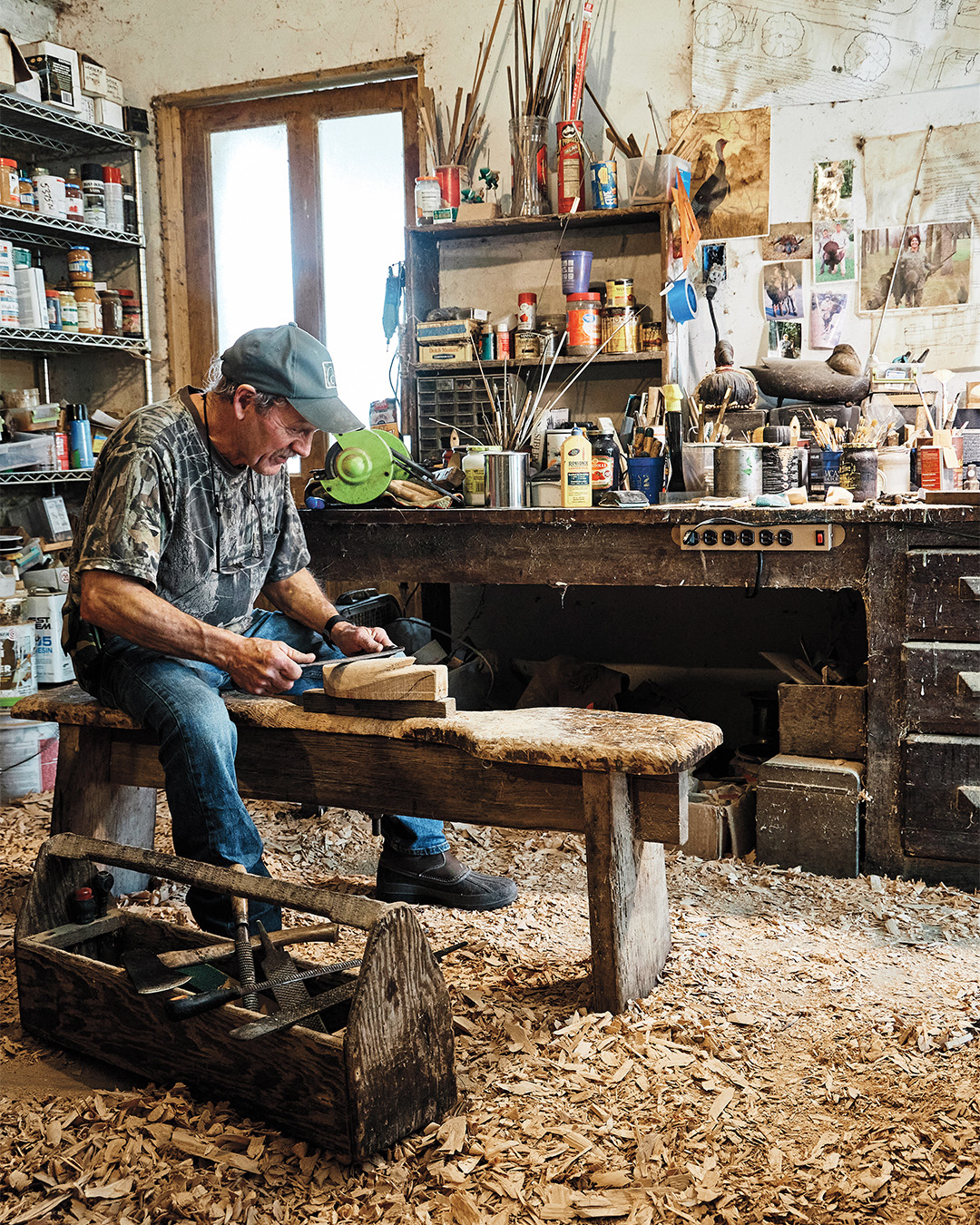
Boozer uses only traditional hand tools to create his stunning decoys. Though many collectors assign their Boozer decoys to a permanent spot on a shelf or fireplace mantel, each one is made to be hunted over.
Boozer is a wiry, mustachioed 74-year-old with the energy of a teenager. Ask him a question, and you’d better be ready to listen, because he’s likely to spin an answer out of a wild web of maritime history, materials dynamics, artistic references across three or four centuries, and his own experience as a devoted duck hunter. When he was in the first grade, in Columbia, South Carolina, Boozer’s school class took a field trip to Fort Sumter, the famed Civil War fort in Charleston Harbor. Boozer was enthralled with the tactile feel of history in the fort’s timbers and bricks, and when he got home, he made a small model of the fort using sticks for cannons and cardboard for walls.
That was the beginning of a lifetime of fascination with the intersection of art and history. Boozer went on to earn a bachelor’s in art and architectural history from the University of South Carolina and spent a career as an architectural designer for a banking chain. But he carved ducks and shorebirds on the side, which led to customers asking for small models of their personal boats. “They would send me photographs and boat dimensions, and I would build their exact boat, with the hunter and his dog sitting in the bow,” he says. “And oh boy, I’ve carved a bunch of little Benelli shotguns.”
A turning point came in 1984, when a customer asked him if he could make a model of one of the market hunting boats documented in The Outlaw Gunner. Boozer was a fan of the book but was unsure about the legalities of building a boat model based on someone else’s photographs. He reached out to Walsh in a phone call that kicked off a years-long friendship. Walsh was excited about Boozer’s project, and the pair would talk on the phone for hours. At his home in Chestertown, Maryland, Walsh would measure each element and send the details to Boozer: Every plank in the boats, plus the decoys, marsh poles, ice hooks, powder horns, battery guns, and gunning lanterns, all the way down to brass shell casings.
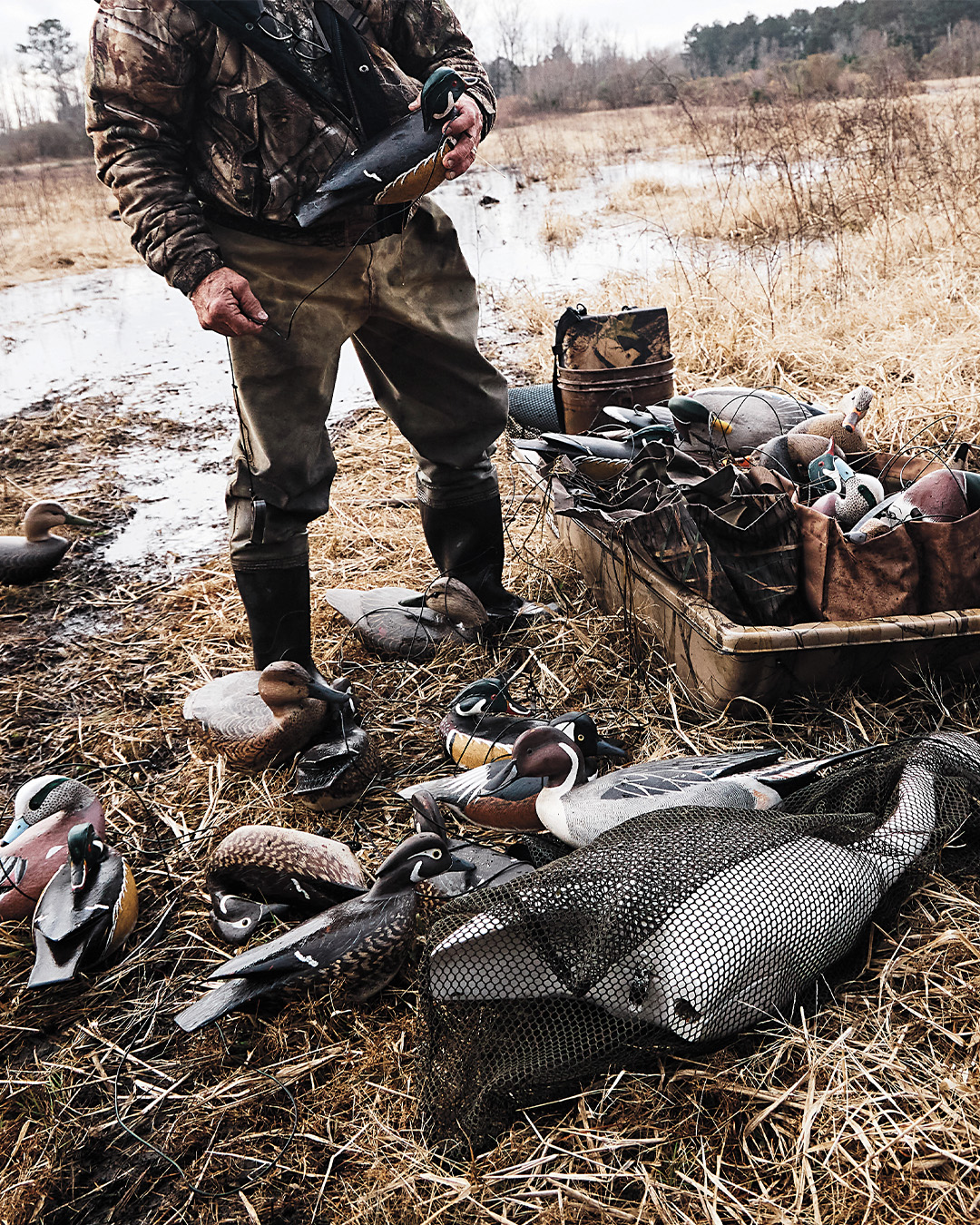
Walsh would direct Boozer to a certain page in his book and point out details in a photograph. How much difference should there be in the diameter of a scaled-down .58-caliber musket barrel compared to a .69-caliber percussion flintlock barrel? What were the dimensions of a hand paddle, used by the night hunters with their handmade gunning lights to close the final distance on rafts of thousands of ducks?
Piece by piece, and plank by plank, Boozer built a database of measurements from which to carve. He’s no sloucher for details. Each boat is built to what is known as “Type 1 confirmation.” That means every piece of the model must be made by hand, and from raw materials. That requires a mind-boggling mix of artistic talent, technical skill, and the patience of Job.
“Look here,” Boozer says. He points to a five-barreled battery gun on one of the models. The working battery guns were made by welding pieces of a .22 rimfire barrel in between the multiple barrels, with a single ignition hole bored from one side of the contraption to the other. A pair of lanyards was used to fire percussion caps simultaneously on each side of the barrel array. The battery gun assemblage was set into Portland cement in order to handle the monstrous recoil.
“So, what do you think I set those little barrels in?” Boozer grins. “A little dollop of cement putty. I can’t be right,” he continues, shaking his head, “to do this stuff.”
But it’s precisely that level of detail that helps bring a critical waterfowling era back to life. Market hunting has long captured the imagination of avid waterfowlers. Part of that attraction is the breathtaking ferocity of the enterprise. Part of it is the fascination with a time period during which duck flights still darkened the skies. And part of it is the allure of all those old-timey boats and decoys and guns and gear. Modern duck hunters aren’t the first to fixate on waterfowling stuff.
But much of what we find fascinating about the time period is the role market hunting played in the story of conservation on this continent. Market hunting was a knife edge in history. On the one side lies a heritage of slaughter. On the other was birthed an entirely new way of looking at mankind’s relationship to nature, and the role of wildlife management in a rapidly changing environment.
The boats and gear and old photographs of market hunters documented in The Outlaw Gunner are now largely in the collections of the Chesapeake Bay Maritime Museum in St. Michaels, Maryland, and the Tilghman Watermen’s Museum on Tilghman Island. Harry Walsh died in 2009, having never met the man from South Carolina who turned his obsession with waterfowl history into a modern expression of maritime art.
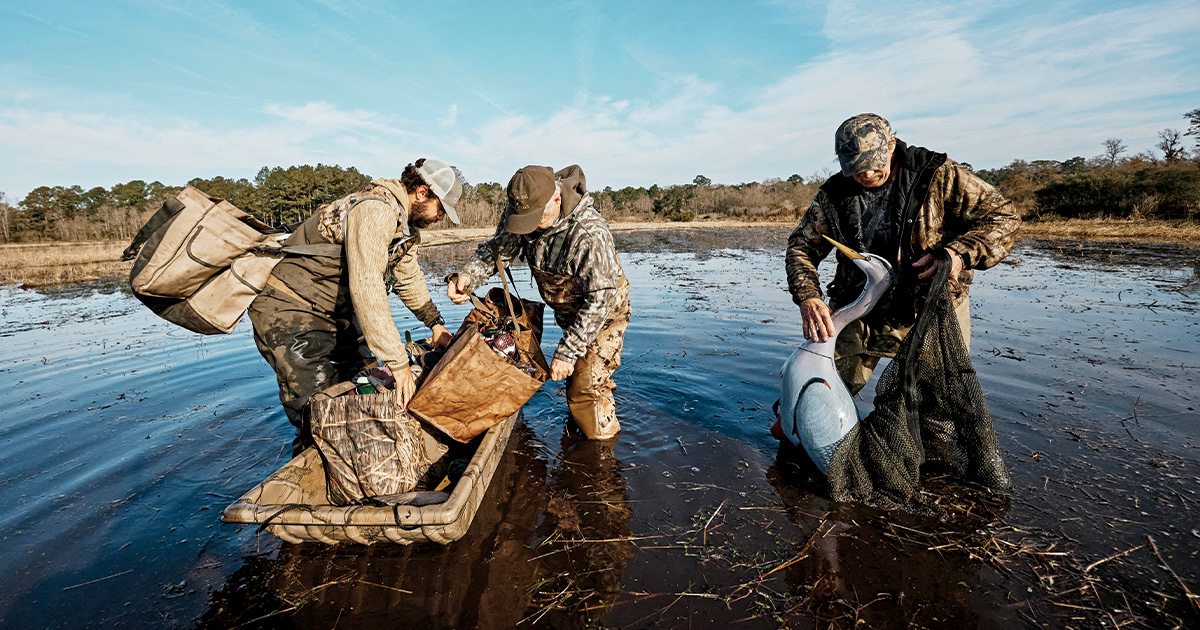
In addition to his stunning duck decoys, Boozer carves working confidence decoys such as herons and egrets, to add realism to his spread/
In the dark, in a Lowcountry rice field, Boozer puts out 31 wooden decoys, including a full-size great blue heron and egret. His grandfather, he explains, always put out odd numbers of decoys. “Never even,” Boozer insists. “I don’t know why he did it that way, but he did. And I’ve always done it that way, too.”
Boozer tells me this as he pulls out a small decoy bag filled with his hand-carved wood ducks and hooded mergansers, which are among the most arresting carved decoys I’ve seen. Maybe it’s because I’m a hunter of the Southern wetlands as well. Maybe it’s because they are just so perfectly beautiful. It’s curious to me that the act of carving a decoy is, on one level, an effort to promulgate an untruth. The carver’s task is to make a beautiful lie. Or, at least, a lie worthy of a closer look. It’s why Boozer and many old carvers pronounce the word “decoy” so it sounds like de-COY. It comes from the Dutch de kooi, meaning “the cage.” It’s a reference to the traps used to capture wild birds, a word that came to be associated with luring an unsuspecting party to an unhappy ending.
We cut wax myrtle branches for a blind and hunker down. We’re with Boozer’s pal, Joey D’Amico. In the spirit of the old Dutch, D’Amico is another professional liar. Under the brand name Tekton Game Calls, he crafts hand-turned custom duck calls that have fooled ducks from Saskatchewan to south Louisiana. Clouds skitter overhead, the changing light making the decoys glimmer and dance. Through the wax myrtle branches, the lemon-colored flank feathers on Boozer’s wood ducks and the white crests on the hooded mergansers flash in and out of sight.
To our right, three wood ducks zip down the levee, heading away, then turn a sharp 180 and beeline for the decoys. They never suspect a thing. We drop two, one of them a late-season fully plumed drake.
I ask Boozer to hold it up next to one of his decoys. The two birds, the real and the unreal, are close to mirror images. I shouldn’t be surprised.
The next morning, in Boozer’s shop, I was hunched over another diorama. This time I had a goal in mind: Boozer had pointed me to this model of a historic Edisto River property and told me there was a tiny painted bunting somewhere in the sprawling array of miniature trees, fields, cabins, and barges tied up at a wharf. It all fits on a display about three feet by three feet. “See if you can find it,” he says with obvious glee.
While waterfowlers swoon over Boozer’s boat models, his historically accurate dioramas are a hit with private collectors and with museums and environmental education centers. He’s had work displayed at the South Carolina Maritime Museum in Georgetown, the Edisto Island Museum, and the South Carolina State Museum, including dioramas of old oystering sloops and the Confederate submarine H.L. Hunley. He is currently working on a diorama of the Georgetown, South Carolina, waterfront of 1905.
A favorite of mine is his diorama of a Back Bay duck hunting camp, circa 1910. Back Bay is just north of Currituck Sound, on the border of Virginia and North Carolina, and the scene includes a battery gun and boat, two working skiffs—one filled with hand-carved hand-painted decoys the size of a green pea—and a half-dozen hand-carved men at work carving decoys and processing ducks.
“I’m insane,” Boozer mutters as he points out the different elements. “I have to be insane to do this.”
“OK,” I finally agree. “Maybe just a little crazy.”
“Let me tell you something,” he counters. “Sometimes I’m working hard and concentrating so much that I can almost hear voices just outside the shop. Somebody will yell, Hey, man, hand me that maul! Or holler: Speed up! Let’s get a move on! And I have to look around to convince myself that I’m not back there, not back in time.”
He smiles a wry, knowing smile, as though being this kind of nuts is a blessing and a gift.
“I’m crazy,” he says. “There’s just no other explanation for what I do. But it sure is fun.”
Ducks Unlimited uses cookies to enhance your browsing experience, optimize site functionality, analyze traffic, and deliver personalized advertising through third parties. By continuing to use this site, you agree to our use of cookies. View Privacy Policy